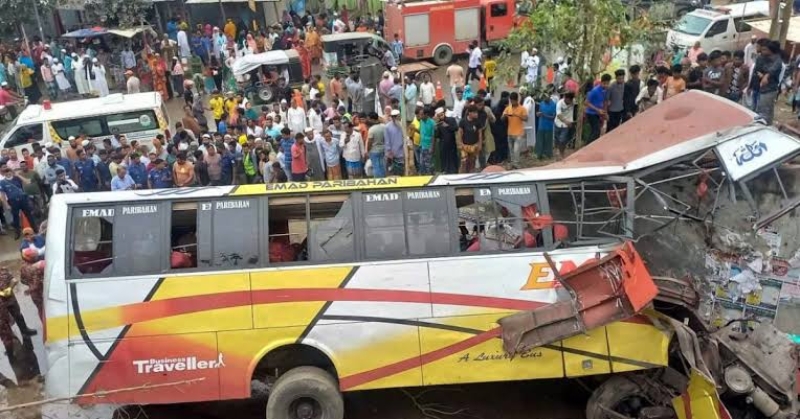- Irregular entry, false asylum claims harm Bangladesh’s global standing |
- Dhaka breathes ‘very unhealthy’ air Tuesday morning |
- Election Code of conduct gazetted, banning posters-drones, AI misuse |
- Rivers Keep Swallowing Land as Bangladesh Battles Erosion |
- UN Warns Refugees Caught in Climate–Conflict Cycle |
Road Crashes Claim 604 Lives in March

In yet another grim chapter for Bangladesh’s worsening road safety record, a total of 587 road accidents in March 2025 claimed 604 lives and injured 1,231 others, according to the latest report from the Road Safety Foundation.
The month’s toll starkly highlights the persistent dangers faced by commuters and pedestrians alike, as the country struggles to stem the tide of preventable deaths on its highways and byways.
Among the victims were 89 women and 97 children, underscoring how road dangers cut across all sections of society, sparing neither the young nor the vulnerable. The tragic figures serve as a chilling reminder of the urgent need for comprehensive road safety reforms.
The report draws on data collected from nine national dailies, seven online news portals, various electronic media outlets, and the foundation’s own field reports. It provides a sobering snapshot of the state of transport safety, extending beyond roadways to incidents on water routes and railways.
Motorcycles, once hailed as an affordable and efficient mode of transport, continue to top the list as the most dangerous vehicles on the country’s roads. Of the total 587 accidents recorded, motorcycles were involved in 242 cases, causing the deaths of 233 people. This represents over 38% of all fatalities and 41% of total reported crashes.
Experts point to multiple factors contributing to this alarming trend, including a surge in motorcycle ownership, often without adequate driver training or proper licensing. Reckless driving, overspeeding, inadequate enforcement of helmet laws, and poor road conditions further worsen the risks for motorcyclists and pedestrians alike.
Many young riders, drawn by the low cost and convenience of motorcycles, often flout traffic regulations, while delivery drivers and rural commuters rely heavily on two-wheelers, placing them in daily danger.
Pedestrian casualties remain another stark concern, with at least 109 people killed while crossing roads or walking alongside traffic. This represents 18% of the total death toll for March.
The absence of dedicated pedestrian lanes, overbridges, and safe crossings forces many people to navigate hazardous roadways on foot. Rapid urbanisation without proportional investment in pedestrian-friendly infrastructure has only intensified these risks.
Urban planners and road safety advocates have repeatedly called for better urban design and public awareness campaigns to protect pedestrians, particularly in densely populated cities like Dhaka, where jaywalking and overcrowded footpaths are common.
Transport workers also paid a heavy price. The report reveals that 98 drivers and their assistants were killed in March, accounting for over 16% of all fatalities.
Long working hours, poor vehicle maintenance, inadequate rest facilities, and the immense pressure to meet tight delivery schedules continue to push commercial drivers into risky behaviour behind the wheel. These occupational hazards make driving one of the deadliest professions in Bangladesh.
The report expanded its focus beyond road accidents, revealing that six incidents on waterways claimed nine lives and injured 14 others.
Bangladesh’s reliance on river transport, particularly in rural areas, makes waterway safety a crucial issue. Overcrowding, poorly maintained vessels, and a lack of life-saving equipment continue to plague riverine transport.
Similarly, railway accidents claimed 19 lives and injured four people in March across 16 incidents. Unprotected level crossings, signal failures, and illegal encroachments on railway lines are persistent hazards contributing to these fatalities.
Dhaka Division, the most densely populated region in the country, recorded the highest number of fatalities. Regional roads accounted for the largest share of crashes, reflecting a nationwide issue of inadequate road safety measures and enforcement beyond urban centers.
High-speed traffic, narrow roadways, and insufficient monitoring by traffic authorities in regional areas often result in a lethal mix, increasing the risk of serious accidents.
Road safety experts warn that these alarming figures point to a deteriorating situation unless immediate, coordinated action is taken. They are urging for stricter enforcement of traffic laws, improvements in road infrastructure, public awareness campaigns, and investment in safer transportation systems.
Md. Ilias Kanchan, a prominent road safety activist and founder of Nirapad Sarak Chai (We Demand Safe Roads), reiterated that without a national emergency response, the human cost will continue to rise.
“We need rigorous law enforcement, proper licensing systems, safe pedestrian crossings, and public education campaigns to curb this bloodshed,” Kanchan stressed.
The government has pledged to reduce road fatalities under its Sustainable Development Goals (SDG) commitments. However, progress remains slow, hampered by bureaucratic delays, resource constraints, and lack of coordination among agencies.
While Bangladesh has made efforts to improve road conditions and introduce digital enforcement tools like speed cameras and automated fines, experts argue that piecemeal efforts are not enough. Comprehensive reforms, including road engineering improvements, driver education, and better emergency response systems, are crucial.
In the meantime, families continue to mourn their lost loved ones, and thousands more live with the scars of preventable tragedies.
As Bangladesh heads deeper into 2025, road safety advocates hope that reports like this will galvanize policymakers into action—turning grim statistics into a catalyst for lasting change.

